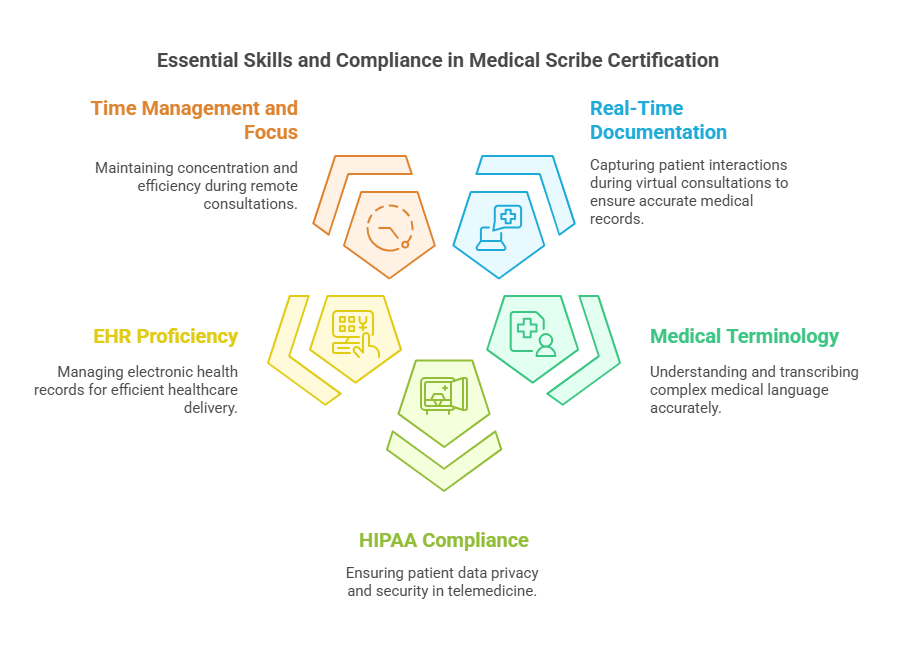Medical Scribe Certification and Telemedicine: The Future of Remote Scribing
The healthcare industry has seen rapid advancements over the past decade, with one of the most transformative changes being the integration of telemedicine and remote healthcare solutions. As these technologies continue to evolve, one area gaining significant attention is the role of medical scribes, specifically remote or telemedicine-based medical scribes. Telemedicine has revolutionized the way doctors interact with patients, and now, medical scribe certification plays an increasingly important role in ensuring quality care and accurate documentation in these virtual healthcare settings. This article will explore the connection between medical scribe certification and telemedicine, delving into the future of remote scribing, its impact on the healthcare industry, and why medical scribe certification is crucial in this new landscape.
The Rise of Telemedicine in Healthcare
Telemedicine refers to the use of digital platforms to provide remote healthcare services, including consultations, diagnostics, treatment, and monitoring. With the increasing demand for remote healthcare, especially in the wake of the COVID-19 pandemic, telemedicine has become a cornerstone of modern healthcare delivery.
In 2025, telemedicine continues to grow, offering patients greater access to medical care regardless of their geographic location. For healthcare providers, telemedicine improves efficiency, reduces overhead costs, and expands the patient base. But while the benefits of telemedicine are numerous, it also comes with unique challenges—chief among them, maintaining accurate and comprehensive medical records.
The Role of Medical Scribes in Telemedicine
A medical scribe is a trained professional who works alongside healthcare providers to document patient information in real-time during medical consultations. They ensure that all critical data is accurately recorded in the patient's electronic health record (EHR), allowing physicians to focus on providing care rather than administrative tasks.
In telemedicine, medical scribes play a crucial role in maintaining the same level of documentation accuracy as they would in an in-person consultation. However, telemedicine requires medical scribes to operate in a virtual environment, often using specialized software and video platforms to monitor and document the interaction between the healthcare provider and the patient. This remote nature of scribing demands specific training and expertise, which is where medical scribe certification comes into play.
The Importance of Medical Scribe Certification
Medical scribe certification has become a fundamental credential in the healthcare industry, ensuring that professionals are equipped with the necessary skills to provide accurate, reliable, and compliant documentation. Medical scribe certification guarantees that medical scribes are proficient in medical terminology, patient documentation procedures, HIPAA compliance, and all other aspects of healthcare documentation. This certification is especially crucial in the rapidly growing field of telemedicine, where accurate and timely documentation is essential to providing effective care. With telemedicine becoming increasingly common, the demand for skilled and certified medical scribes is higher than ever.
Certified medical scribes are trained to perform a variety of critical tasks that ensure healthcare providers can focus on patient care instead of administrative duties. These tasks include:
Real-Time Documentation: In telemedicine, scribes are tasked with documenting patient interactions in real time. This means that during virtual consultations, scribes must capture every detail of the conversation, ensuring the medical record is both complete and accurate. This documentation is vital for continuity of care and compliance with healthcare regulations.
Medical Terminology: Scribes must possess an in-depth understanding of medical terminology, enabling them to accurately transcribe patient symptoms, diagnoses, treatment plans, and follow-up instructions. With telemedicine consultations occurring remotely, the ability to correctly interpret and document complex medical language becomes even more important.
HIPAA Compliance: Protecting patient privacy is of the utmost importance in telemedicine. Certified medical scribes are well-versed in HIPAA (Health Insurance Portability and Accountability Act) regulations, ensuring that patient data is secure and confidential. They safeguard sensitive information during remote consultations by following best practices for digital security and maintaining the integrity of patient records.
EHR Proficiency: Electronic Health Records (EHR) are a cornerstone of modern healthcare, and certified medical scribes are skilled in managing these systems. They ensure that patient information is accurately entered into EHR systems, organized properly, and easily accessible for healthcare providers. A thorough understanding of EHR platforms ensures efficiency and accuracy in documentation, making it easier for doctors to access patient history and make informed decisions during telemedicine visits.
Time Management and Focus: Remote scribing in telemedicine requires excellent multitasking skills. Scribes must stay focused during virtual consultations, documenting key information while maintaining an awareness of the physician's needs. Efficient time management is essential to ensure that the physician can continue their workflow without unnecessary interruptions, all while ensuring that no important details are missed in the patient record.
The Future of Remote Scribing in Telemedicine (2025 and Beyond)
As the healthcare landscape continues to evolve, telemedicine stands at the forefront of this transformation. The widespread adoption of telemedicine has created a growing demand for remote medical scribes, and this trend is expected to accelerate as technology continues to reshape healthcare delivery. As telemedicine becomes more deeply integrated into healthcare systems around the world, the role of remote scribes is set to become even more essential. In 2025 and beyond, the future of medical scribe certification will be closely linked to these advancements, with several key trends shaping the industry.
Increased Demand for Remote Healthcare
With the continued mainstream adoption of telemedicine, the need for remote medical scribes is expected to rise significantly. As more patients turn to virtual consultations for convenience and accessibility, the demand for professionals who can document these interactions in real-time will increase. Certified medical scribes will become increasingly vital as they ensure accurate and timely documentation, which is essential for maintaining high standards of patient care in a remote setting. The growing prevalence of telemedicine will make scribe certification even more valuable, as it guarantees that scribes are proficient in the unique demands of remote healthcare.
Integration of AI and Automation
Artificial intelligence (AI) and automation are already making their mark on telemedicine platforms, streamlining workflows and improving efficiency. AI is being used for tasks such as transcription, voice recognition, and even decision support, helping to automate some aspects of the documentation process. However, despite these technological advances, certified medical scribes will remain crucial for verifying AI-generated data, handling complex cases, and ensuring that the AI systems comply with medical standards. Scribes will play a key role in overseeing the accuracy of automated processes, which is essential for maintaining the integrity of patient records.
Expansion of Telemedicine Specialties
Initially, telemedicine was primarily used for primary care consultations, but its reach is expanding to encompass a wide range of specialties, including mental health services, specialist consultations, and even remote surgical assistance. As telemedicine continues to grow across diverse medical fields, the need for medical scribes with specialized knowledge will also increase. Certified scribes will be in high demand across various specialties, each requiring a unique set of skills and expertise. From dermatology to cardiology, scribes will need to understand the specific language, treatments, and protocols for each area of care, further emphasizing the importance of obtaining a certification that reflects this specialized knowledge.
Enhanced Training Programs
As the need for remote scribes grows, so will the demand for more advanced and specialized training programs. Certification programs will evolve to address the new challenges posed by telemedicine, such as the use of specific telehealth tools, platforms, and communication protocols. Training programs will also incorporate the latest updates on HIPAA compliance and privacy standards, ensuring that scribes are fully prepared to navigate the complexities of telemedicine. With healthcare becoming more digital and remote, these enhanced training programs will ensure that medical scribes are equipped with the skills necessary to support the ever-changing telemedicine landscape.
Global Reach of Telemedicine
Telemedicine is not only flourishing in developed countries but is also expanding into developing regions, offering healthcare access to underserved populations. This global reach presents an exciting opportunity for certified medical scribes to work remotely across borders, providing virtual support to healthcare providers worldwide. As more countries embrace telemedicine, the need for remote scribes will become increasingly international. This global market will offer new career opportunities for certified scribes and make medical scribe certification a highly sought-after credential in the global healthcare ecosystem.
Lesser-Known Facts About Remote Scribing and Telemedicine
Telemedicine Adoption Grew by 38% in 2020: The COVID-19 pandemic forced a rapid shift to telemedicine, with a 38% increase in telemedicine visits in 2020 compared to the previous year. (Source: CDC)
Virtual Visits Account for 25% of U.S. Healthcare Visits in 2025: A recent study predicts that virtual healthcare visits will account for a quarter of all healthcare visits in the United States by 2025. (Source: McKinsey & Company)
Telemedicine Improves Patient Satisfaction: Studies have shown that patients using telemedicine report higher levels of satisfaction due to convenience, reduced wait times, and the ability to consult from home. (Source: Health Affairs)
Telemedicine Reduces Healthcare Costs: A report from the American Medical Association found that telemedicine could reduce healthcare costs by as much as 10-15%. (Source: AMA)
Scribes Reduce Physician Burnout: Certified medical scribes play a critical role in reducing physician burnout by allowing doctors to focus on patient care rather than administrative tasks. (Source: Annals of Family Medicine)
Medical Scribe Certification Improves Job Performance: Certified medical scribes are more likely to excel in documentation, accuracy, and efficiency compared to non-certified professionals. (Source: Journal of Medical Scribing)
AI Can't Fully Replace Scribes: While AI technology is improving, it cannot fully replace human scribes, especially for complex cases requiring judgment and accuracy. (Source: AI in Healthcare)
Telemedicine Supports Chronic Disease Management: Telemedicine is particularly beneficial for managing chronic conditions like diabetes, hypertension, and asthma, offering patients more frequent monitoring and care. (Source: American Heart Association)
Telemedicine is Expanding Internationally: Countries like India, China, and Brazil are expanding telemedicine services, creating more opportunities for remote scribes globally. (Source: World Health Organization)
Telemedicine Reduces Emergency Room Visits: Research indicates that telemedicine consultations can reduce unnecessary emergency room visits, especially for minor health issues.
Conclusion
As telemedicine continues to reshape the healthcare landscape, the role of remote medical scribes is becoming more critical. Medical scribe certification ensures that professionals are well-equipped to navigate the complexities of remote scribing and contribute to efficient, accurate patient documentation in telemedicine. With telemedicine expected to expand rapidly in 2025 and beyond, the demand for certified medical scribes will only grow, and those with the proper certification will be in high demand. At ACMSO, we provide comprehensive medical scribe certification programs to help individuals pursue a rewarding career in this rapidly evolving field.
FAQs
-
A medical scribe is a trained professional who assists healthcare providers by documenting patient information in real-time during consultations.
-
While certification is not mandatory, it is highly recommended. Certification ensures that scribes have the necessary knowledge of medical terminology, EHR systems, and HIPAA regulations.
-
Yes, medical scribes can work remotely, especially in telemedicine settings where they document virtual consultations.
-
Medical scribes in telemedicine help ensure accurate documentation, improve efficiency, reduce physician burnout, and enhance patient care
-
The future of telemedicine is bright, with continued growth expected. Medical scribe certification will be increasingly important as more telemedicine services are offered globally.






